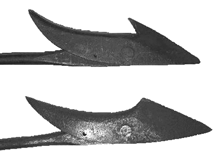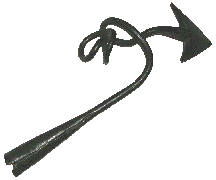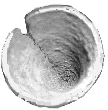 Whalecraft
Whaling
Whalesite
Whalecraft
Whaling
Whalesite


Erroneous information about whalecraft is commonplace. This is due primarily to not knowing or understanding the use for these implements or how they were made. Misinformation stems from decorative reproductions specified as authentic, out and out fakes and implements from other industries mistakenly identified as whaling implements. Most commonly mistaken are hay forks, hay knives, block knives, draw knives, silage choppers, slicks, logging tools and even a patented sewer cleaner identified as a whaling harpoon! A good place to look for some of these items would be a book on vintage farm implements such as Eric Sloan's Museum of Old Tools or Frank Barnes' Hooks, Rings & Other Things or John Vince's Old Farm Tools, An Illustrated Guide. There are also implements from other fisheries, such as swordfish darts, boat hooks, fish and eel spears identified as whaling items. And there are many harpoons, lances and spades used in the Azores whaling industry until the 1970's that are being mistaken as authentic vintage New England whalecraft. It is also important to note that some museums are misinformed; just because an implement is identified in a museum as authentic whalecraft, it is not necessarily so, especially if the museum is not specifically focussed on whaling or other fisheries. A local Historical Society Museum, for example, may not have staff specifically trained or knowledgeable in whalecraft, and they can make wrong judgements based on misinformation or no information. Many people will tend to take it as absolute truth simply because the information came from a museum.
This page is an effort keep the information about whalecraft unadulterated, and to provide a source for those who are seeking information on an implement and can't find it in the whalecraft pages. You may find that it is not a whaling implement at all. It may also help those considering an addition to their collection to avoid polluting an otherwise good whaling collection. It serves to further understand whalecraft from the point of view of what whalecraft is not. And hopefully it will help prevent the distribution of misinformation.
Areas to look for when examining a harpoon or other whaling implement are:

Harpoon Heads 
Above: Two common styles of toggle heads. Compare to the Azores toggle head below. 
Azores toggle head. The head of a toggle iron, or any whale iron, was always iron, never brass or bronze. (There are brass or bronze swordfish darts that should not be confused with whale irons, although I have seen swordfish darts being sold as whale irons. These swordfish darts are in use today). There were some experimental harpoons and guns that did utilize brass for portions of the implement, but for reasons of firing mechanisms and parts that could otherwise produce a spark in the presence of gunpowder. Some guns and gun mechanisms would become too brittle
in cold climates such as the Arctic and could break under the stress of an explosion if they were made of iron. But, for practically all standard harpoons the material for the head was cast iron or wrought iron.
Bronze swordfish dart, 4-3/4" long.
If in doubt, try a magnet; if it is attracted to the head, it is iron. Toggle heads, both Temple irons and improved toggles, and some experimental and patented irons were malleable cast iron, not forged by the blacksmith. They should be smoothly finished and pivot on the shaft smoothly without any slop or side play. There will be a small hole completely through the head and shaft for a small wood pin the size of a match stick that would keep the head streamlined for darting, but would shear and allow the head to toggle when strain was put on the whale line. This small hole was aft of the pivot pin.
The head of a toggle iron was about 7" long. The head of an Azores toggle iron was longer, about 8", and appeared to be more narrow or "sleek" (see examples above). Also, Azores irons were made by forging the socket around the end of the shaft, so you will not see the socket inside tapering to a fine point. This is especially true of later Azores irons.
The heads of two flue or single flue irons were also iron, and were forged by the blacksmith. Often close inspection of a two-flue or single-flue head will reveal lines where parts of it were forge welded together, and forge welded to the shaft. Again, these forge welds are smooth and well made. (Only wrought iron was forge welded; cast iron could not be forge welded).
Back to top.
Pivot PinThe toggle iron pivot pin was wrought iron on which the head toggled open. The pin itself was 3/8" diameter, but the part visible at the
side of the head should be 1/2"; that is the ends that flared out like a rivet to secure the pin. Since the pivot pin was wrought iron and the head was also iron, there should be no corrosion in that area. Dissimilar metals would result in galvanic corrosion and produce pronounced rusting of the pivot pin. (That is one reason that the head was never brass or bronze, aside from the fact that these materials simply were not strong enough). The pivot pin was always finished smoothly and flush with the side of the head, never protruding beyond the side. The pin should be
firmly installed and should rotate with the toggle head. If the pivot pin is smaller, but the iron otherwise looks good, consider that it may be a blackfish or porpoise iron. These did not have to secure the load of a whale towing a fully loaded whaleboat and therefore the pivot pin could be smaller. The head is usually smaller, too, and the shaft may be shorter because it did not have to penetrate the thickness of whale blubber.
Both pivot pins shown above are authentic. Note that they are flush with the side of the toggle head and are about 1/2" diameter at the outside. (Author's collection). Back to top.
SocketIf possible look closely inside the socket of any whalecraft. (A small flashlight is a good aid.) The cone was forge welded with the shaft, and was not forge welded around the shaft. The socket was hammered flat into a fan shape and then the fan was rolled into a cone to form the socket. Therefore, you should see the socket tapering to a point inside; you should not see the cut end of the shaft. This is true of all whalecraft with a socket. The visible cut end of the shaft is a
dead give away. If you cannot look into the socket, closely observe the outside of the socket where it is joined to the shaft. This should be a very smooth and gradual transition, not abrupt. The abrupt transition is due to the socket being forged around the shaft.
Left:Socket tapers to a point inside. Right: Cut off end of the shaft is visible. (Author's collection). Harpoons were meant to become detached from the pole after they were fast to a whale. This prevented the weight of the pole from working to withdraw the harpoon. Therefore, there should not be a pin or rivet or screw or small hole for such a pin in the socket used to fasten the harpoon to the pole. This fact is often overlooked by those making fakes and reproductions. On the other hand, spades and boarding knives should not become detached, and they often do have such a hole in the socket. Harpoon sockets should have an open seam along the length of the socket. This provided a spring clamp action to grip the pole when the pole was forced into the socket. Remember, the harpoon was otherwise not secured to the pole. Many reproductions and fakes have a closed seam, i.e., no open gap along the length of the socket. Some reproductions may have an open seam, but very straight and of a uniform width gap; authentic harpoon sockets were not so uniform, but appear uneven, hammered into shape. Spades, boarding knives, pikes, bailers etc. did have closed seams along the socket to add strength. Skimmers, bailers and forks had even more support to the socket because they lifted heavy loads. These were pinned to their pole as mentioned above.
Back to top.
MarkingsHarpoons are not always marked, or "signed". The blacksmith's identification is often, but not always, stamped into the head. These marks are not superficial scratches or chisel marks; they were made by a steel stamp while the head was red hot. Any superficial chisel markings are the whaleship identification, and some sort of identification of the whaleboat in which it was used. Spades and lances have only the blacksmith's identification, if that; only harpoons had any other identification.
See the page on Markings for a more detailed discussion and examples of these various marks found on whalecraft.
Back to top.
Protective FinishTraces of red or orange paint may be found on some whalecraft. This is normal and was used to prevent corrosion. When the whalecraft was selected for use on the whaleship, it was cleaned off and sharpened. In the case of harpoons, it was also marked with the whaleship and whale boat identification at that time.
Then it was mounted to a wood pole. None of this preparation was done on shore (except shore whaling stations). Often whalecraft may have been cleaned in recent days to remove the paint. Occasionally some traces may still be seen inside the blacksmith's stamped identification, crevices, joints or other such areas.
Orange protective paint on a lance blade.
Back to top.
Shaft
A typical harpoon, or whale iron, was about 2-1/2 feet to 3-1/2 feet long (excluding the pole) with a 3/8" diameter wrought iron shaft. The shaft should not be perfectly straight, but should look like a blacksmith had banged it around a bit. Remember, the shaft was made of soft wrought iron so it could withstand the twisting and bending of a whale trying to flee. It was easy to deform, and could be tied in a knot without breaking. It should not look like a modern extruded rod.
Author's collection
Back to top.
Iron PolesIt is rare to find an authentic harpoon still mounted to its original pole, but not impossible. Not very many whalemen would bother to carry a mounted harpoon ashore; much too cumbersome, and no practical reason. They viewed these implements as tools, not works of art or collectibles or souvenirs. These tools were used at sea, not ashore. Therefore, be careful if the harpoon is mounted to a pole. Iron poles (meaning poles for whale irons, not poles made of iron) should be naturally crude and rough; that was to provide a better grip for wet hands. Originally the bark was left on for a better grip, but often due to age this may have come off. The poles were usually hickory or other hardwood tree branches or small trunks, and not smoothed out or turned to make them round. They were not very heavy, but tended to be smaller diameter than many think. If a pole is a nice smooth, uniformly round and straight pole, it is not authentic. The color of old iron poles tends to be more light colored, like driftwood; most often reproductions are stained a nice rich wood color that looks good hanging on your wall. Also, the wood would have shrunk over time and the fit in the socket will now be loose. If it is rigidly tight, consider that it was put there recently. Expect to pay quite handsomely for a harpoon mounted to its original pole. Also, be aware that these authentic poles were available a few years ago in bundles at an auction on Cape Cod. Some dealers bought them with the idea of putting authentic harpoons on authentic poles, but they were not originally together. That doesn't make it bad, just more expensive, but be aware of the fact. Also, because the Azores whaling industry was shore whaling, there were some harpoons mounted to poles stored on shore, and many of these are available today.
Back to top.
Seizing and WhalelineThe seizing around the socket, if present, and the whale line if there is a short warp, should show signs of age; dark color and some degree of deterioration.
Whale line was natural rope made of hemp or manilla, not any modern synthetic, and never cotton. The short warp was stopped, or tied to the iron pole at two points along the pole with marline or "small stuff." The short warp was secured around the iron at the socket by a
double round hitch and splice. This is another area where many reproductions are obvious. Many reproductions simply wrap the line around the socket a few turns. The short warp ended in an eye splice just forward of the butt end of the pole on an authentic harpoon; it was not longer or doubled.
Above: Proper method of securing line with double hitch and splice.
Below: Obvious reproduction; wrong line, wrong knots, wrong pole, abrupt socket transion to shaft.
Whaleline was two-inch circumference, about 5/8" diameter or more. It was compact and smooth; there were no loose fibers sticking out like whiskers, such as on the reproduction pictured above. Careful examination will determine whether the line is original or a modern replacement or reproduction. See more information about whale line on the Harpoons page.
Back to top.
Tools mistaken for whaling implements. The following is a collection of tools from other industries that are often mistaken as whaling implements. These tools are for farm work, logging, other fisheries, woodworking, sewer cleaners - practically anything that may in some way resemble a whaling implement. Frequenly called whaling tools are hay forks, hay harpoons, draw shaves, block knives, slicks, brush cutters, barking spuds, silage choppers, hay knives, grappels, eel spears, peaveys, etc. (Note: None of the following examples are from the New Bedford Whaling Museum).
This hay hook is often mistakenly identified as a harpoon, probably because it is large, iron and has two barbs that open outward. It was dropped into a bale of hay on a wagon, and after it was inside the bale tension on the rope attached to it opened the barbs so the bale could be lifted
into the loft of the barn. A trigger released the barbs so it could then be withdrawn. It appears to be quite similar to a hay hook patented by F. H.Bolte in 1884 (U.S. Patent No. 307,906, Nov. 11, 1884).
Hay hook for lifting bales of hay into the barn loft.
A slick was a large wood chisel used for smoothing, such as the edges of
boards planking a ship where they butted along the edge. The slick was pushed by the carpenter's shoulder. It was about three feet long.
Slick; a large wood chisel.
The hay hook is often mistaken for a whale harpoon, probably because it somewhat resembles a single flue iron. The hay hook was shorther than a harpoon and was secured to a wood pole. It was thrust into a haystack and then withdrawn, pulling a sample of the hay from the center of the haystack. In this way a farmer could judge how dry the hay was. See "Hooks, Rings & Other Things, An Illustrated Index of New England Iron, 1660 - 1860," by Frank T. Barnes, p. 40, items 82 and 264.
Back to top of this page

